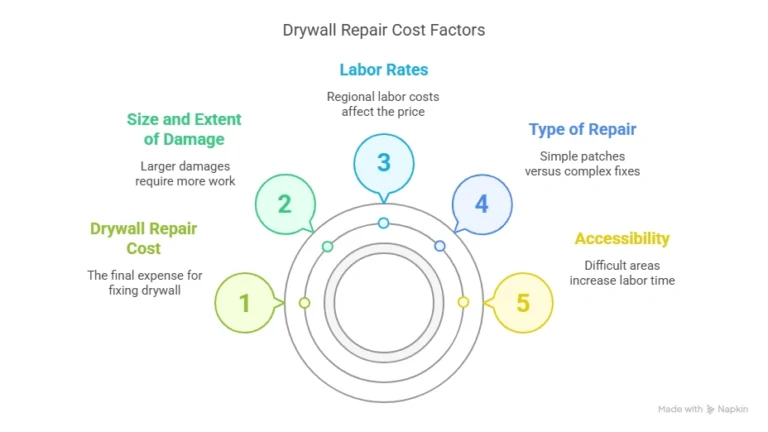Drywall damage has a special talent for showing up at the worst possible time. And right behind it? The dreaded question: How much does drywall repair cost? On average, expect to pay anywhere from $150 to $750 depending on the size and type of damage. But don’t worry—this guide has everything you need to make sense of the numbers and fix that wall hole without emptying your wallet.

Table of Contents
Factors That Affect the Cost of Drywall Repair

Ever wonder why your neighbor paid $100 for a wall repair while you got quoted $400? It’s not just contractor greed – several key factors determine your final bill.
Drywall Repair Materials
The materials you choose make a huge difference in your wallet. Here’s what you’ll need and what it’ll cost you:
Basic Materials:
- Joint compound (drywall mud): $8-15 per gallon
- Mesh tape or paper tape: $3-8 per roll
- Primer: $12-25 per quart
- Matching paint: $15-40 per quart
- Basic tools (putty knife, sandpaper): $20-50
Quality Matters: Cheap compound might save you $5 upfront, but it’ll crack faster than your patience during a Monday morning meeting. Professional-grade supplies cost 20-30% more but last significantly longer.
DIY vs. Pro Supplies: Contractors get better prices on materials, but they mark them up 15-25%. If you’re buying your own materials, shop around – prices vary wildly between big box stores and specialty suppliers.
Drywall Repair Cost Per Square Foot
Size matters when it comes to pricing. Here’s the breakdown that’ll help you budget:
- Small repairs (under 4 sq ft): $75-$150 total
- Medium repairs (4-10 sq ft): $150-$350 total
- Large repairs (over 10 sq ft): $350-$750 total
Labor vs. Materials: About 60-70% of your cost goes to labor, with materials making up the rest. A handyman drywall repair cost typically runs $50-75 per hour, while specialized contractors might charge $75-100 per hour.
Drywall Repair Cost by Type of Solution
Different damage = different solutions = different price tags.
- Patching Compound Repairs: $50-$200 Perfect for small holes and minor dings. Quick, easy, and budget-friendly.
- Mesh Patch Repairs: $100-$300 For medium-sized holes that need reinforcement. The mesh adds strength but bumps up the price.
- Full Panel Replacement: $200-$500 When the damage is too extensive to patch. More expensive but sometimes the only real solution.
- Texture Matching: Add $50-150 to any repair Getting that orange peel or knockdown texture to match perfectly? That’s where the real skill shows, and you’ll pay for it.
FYI, texture matching is where things get tricky—and expensive. Especially when dealing with popcorn or orange peel textures.
Drywall Repair Cost by Type of Damage
The type of damage plays a huge role in cost.
- Tiny holes (like nail pops): $25–$75
- Door Knob holes (2–6 inches): $100–$250
- Big cracks or large holes: $200–$500
- Water damage: $300–$800
- Mold damage: $500–$1,500 (yep, mold ain’t cheap)
If you’re searching for “drywall repair near me,” make sure to check if mold removal is part of the estimate.
Common Causes of Drywall Damage
Let’s get honest: drywall gets beat up more than your old high school backpack.
Here’s what usually messes it up:
- Furniture collisions and door slams
- Leaky pipes or roof (hello, water damage)
- Shifting foundations causing wall cracks
- Humidity and poor ventilation
- Botched past repairs or shoddy installation
And don’t even get me started on pets and toddlers—they’re cute but destructive.
How To Save Money on Drywall Repair
Want to save money on drywall repairs? Of course, you do. Here’s how:
- DIY when it’s small. A little patch kit, some drywall mud, and you’re good to go.
- Buy in bulk during sales if you’ve got multiple spots to fix.
- Bundle repairs—if you’re already getting home repair work done, add drywall to the list.
- Learn the basics. Trust me, knowing how to fix a small hole or nail pop can save you hundreds.
- Prevent future damage. Seal up leaks, install door bumpers, and monitor humidity.
- Always get multiple quotes. Some drywall contractors really like to test your budget.
Professional Help When You Need It
DIY sounds fun—until your “quick fix” ends up looking like a toddler did it blindfolded. That’s when you want to pause and ask yourself: Is it time to call in the pros? If you’re facing major issues like structural damage, electrical wiring, or plumbing near the repair zone, hiring an expert is the smart (and safe) move.
- Water damage that spreads fast and affects other surfaces
- Mold growth that may require full Water Damage Restoration
- Texture matching or ceiling fixes that require professional skill
- Jobs that involve more than just a single patch or repaint
When that moment hits, look for local pros with good reviews—ideally ones that offer Handyman San Diego Services. Ask what’s included in the estimate: Does it cover sanding, priming, and cleanup? And always check if they back their work with a solid warranty.
Conclusion
So, how much does drywall repair cost? It really depends but now you know why. From small holes to large water-damaged sections, the cost varies based on materials, damage type, and whether you’re a DIY champ or hiring the pros.
The key? Act early. Waiting only makes things worse (and pricier). Think about your skill level, weigh the cost of time and tools, and budget for surprise fixes. It’s part of being a homeowner, like it or not. Got damage? Don’t stress, just get it fixed right the first time.
FAQs
How much does it cost to repair a piece of drywall?
It depends on the size of the damage and how it’s fixed. Small fixes might be $75. Larger or textured patches could go up to $500 or more.
How to estimate drywall repairs?
- Measure the damaged area (in square feet)
- Check what materials you need (joint compound, mesh, etc.)
- Add labor if hiring help
- Multiply by local repair cost rates
How much does it cost to repair mold on drywall?
Mold-related repairs often start around $500 and can go up to $1,500 depending on how bad it is. And yes, sheetrock repair cost includes removing and replacing whole sections if needed.
Is drywall repair cheap?
Well… compared to foundation or roof repair? Sure. But ignoring it can cost you more. Wall damage repair cost is manageable if you act fast.
Can I fix my own drywall?
Absolutely—if you’ve got basic skills and tools like a wallboard screw gun or even a Kobalt drywall screw gun. Tons of guides online walk you through fixing drywall, from small holes to entire panels.
